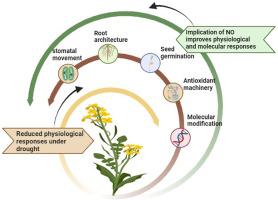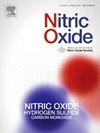An updated mechanistic overview of nitric oxide in drought tolerance of plants
IF 3.2
2区 生物学
Q2 BIOCHEMISTRY & MOLECULAR BIOLOGY
引用次数: 0
Abstract
Drought stress, an inevitable global issue due to climate change, hinders plant growth and yield. Nitric oxide (NO), a tiny gaseous signaling compound is now gaining massive attention from the plant science community due to its unparalleled array of mechanisms for ameliorating various abiotic stresses, including drought. Supplementation of NO has shown its astounding effect in improving drought tolerance by prominently influencing its tendency to modulate stomatal movement and reduce oxidative stress; it can enormously affect the various other physio-biochemical processes such as root structure, photosynthesis, osmolyte cumulation, and seed establishment of plants due to its amalgamation with a wide range of molecules during drought conditions. The production and inhibition of root development majorly depend on NO concentration and/or experimental conditions. As a lipophilic free gasotransmitter, NO readily reacts with free metals and oxygen species and has been shown to enhance or reduce the redox homeostasis of plants, depending on whether acting in a chronic or acute mode. NO can easily alter the enzymes, protein activities, and genomic transcriptional and post-translational modifications that assist functional retrieval from water stress. Although progress is ongoing, much work remains to be done to describe the proper target site and mechanistic approach of this vibrant molecule in plant drought tolerance. This detailed review navigates through the comprehensive and clear picture of the mechanistic potential of NO in drought stress following molecular approaches and suggests effective physiological and biochemical strategies to overcome the negative impacts of drought. We explore its potential to increase crop production, thereby ensuring global food security in drought-prone areas. In an era marked by unrelenting climatic conditions, the implications of NO show a promising approach to sustainable farming, providing a beacon of hope for future crop productivity.

一氧化氮在植物耐旱性中的最新机理概述。
干旱胁迫是气候变化不可避免的全球性问题,它阻碍了植物的生长和产量。一氧化氮(NO)是一种微小的气态信号化合物,由于其在改善包括干旱在内的各种非生物胁迫方面具有无与伦比的机制,目前正受到植物科学界的广泛关注。在干旱条件下,由于氮氧化物与多种分子的结合,它能极大地影响植物的其他各种生理生化过程,如根系结构、光合作用、渗透溶质的累积和种子的形成。根系发育的产生和抑制主要取决于 NO 的浓度和/或实验条件。作为一种亲脂性游离气体递质,NO 很容易与游离金属和氧物种发生反应,并已被证明能增强或降低植物的氧化还原平衡,这取决于是以慢性还是急性模式发挥作用。氮氧化物很容易改变酶、蛋白质活性以及基因组转录和翻译后修饰,从而帮助植物从水胁迫中恢复功能。尽管目前正在取得进展,但要描述这种充满活力的分子在植物耐旱性中的正确靶点和机理方法,仍有许多工作要做。这篇详细的综述通过分子方法全面而清晰地介绍了 NO 在干旱胁迫中的机理潜力,并提出了克服干旱负面影响的有效生理和生化策略。我们探讨了氮氧化物提高作物产量的潜力,从而确保干旱多发地区的全球粮食安全。在气候条件无情的时代,氮氧化物的影响为可持续耕作提供了一种前景广阔的方法,为未来的作物生产提供了希望的灯塔。
本文章由计算机程序翻译,如有差异,请以英文原文为准。
求助全文
约1分钟内获得全文
求助全文
来源期刊

Nitric oxide : biology and chemistry
生物-生化与分子生物学
CiteScore
7.50
自引率
7.70%
发文量
74
审稿时长
52 days
期刊介绍:
Nitric Oxide includes original research, methodology papers and reviews relating to nitric oxide and other gasotransmitters such as hydrogen sulfide and carbon monoxide. Special emphasis is placed on the biological chemistry, physiology, pharmacology, enzymology and pathological significance of these molecules in human health and disease. The journal also accepts manuscripts relating to plant and microbial studies involving these molecules.
 求助内容:
求助内容: 应助结果提醒方式:
应助结果提醒方式:


